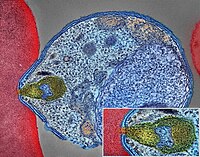
Photo from wikipedia
BACKGROUND Babesiosis is an emerging zoonosis worldwide that is caused by tick-borne apicomplexans, Babesia spp., which threatens the health of domesticated and wild mammals and even humans. Although it has… Click to show full abstract
BACKGROUND Babesiosis is an emerging zoonosis worldwide that is caused by tick-borne apicomplexans, Babesia spp., which threatens the health of domesticated and wild mammals and even humans. Although it has done serious harm to animal husbandry and public health, the study of Babesia is still progressing slowly. Until now, no effective anti-Babesia vaccines have been available, and administration of combined drugs tends to produce side effects. Therefore, non-targeted metabolomics was employed in the present study to examine the temporal dynamic changes in the metabolic profile of the infected erythrocytes. The goal was to obtain new insight into pathogenesis of Babesia and to explore vaccine candidates or novel drug targets. METHODS C57BL/6 mice were infected with B. microti and erythrocytes at different time points (0, 3, 6 , 9, 12, and 22-days post-infection) were subjected to parasitemia surveillance and then metabolomics analysis using liquid chromatography-mass spectrometry (LC-MS). Multivariate statistical analyses were performed to clearly separate and identify dysregulated metabolites in Babesia-infected mice. The analyses included principal components analysis (PCA) and orthogonal partial least squares-discrimination analysis (OPLS-DA). The time-series trends of the impacted molecules were analyzed using the R package Mfuzz and the fuzzy clustering principle. The temporal profiling of amino acids, lipids, and nucleotides in blood cells infected with B. microti were also investigated. RESULTS B. microti infection resulted in a fast increase of parasitemia and serious alteration of the mouse metabolites. Through LC-MS metabolomics analysis, 10,289 substance peaks were detected and annotated to 3,705 components during the analysis period. There were 1,166 dysregulated metabolites, which were classified into 8 clusters according to the temporal trends. Consistent with the trend of parasitemia, the numbers of differential metabolites reached a peak of 525 at 6-days post-infection (dpi). Moreover, the central carbon metabolism in cancer demonstrated the most serious change during the infection process except for that observed at 6 dpi. Sabotage occurred in components involved in the TCA cycle, amino acids, lipids, and nucleotide metabolism. CONCLUSION Our findings revealed a great alteration in the metabolites of Babesia-infected mice and shed new light on the pathogenesis of B. microti at the metabolic level. The results might lead to novel information about the mechanisms of pathopoiesis, babesisosis, and anti-parasite drug/vaccine development in the future.
Journal Title: Microbial pathogenesis
Year Published: 2022
Link to full text (if available)
Share on Social Media: Sign Up to like & get
recommendations!